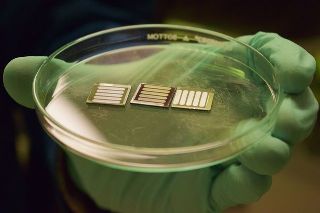Oct 20 2015
Over the last few years, a team of researchers led by Yang Yang, professor at University of California, Los Angeles (UCLA) and member of the California NanoSystems Institute, has created advanced solar cells using perovskite, a material known for its superior ability to convert sunlight to electricity.
 Perovskite solar cells with metal oxide hole and electron transport layers. Credit: Tunde Akinloye/CNSI
Perovskite solar cells with metal oxide hole and electron transport layers. Credit: Tunde Akinloye/CNSI
However, commercialization of the advanced solar cells made from perovskite could not progress further due to the fragile feature of the flexible, very light-weight, and organic-inorganic hybrid material. Within a span of a few hours to a few days, perovskite cells can crumble when exposed to air. The result is much worse when exposed to moisture. This is due to the hydroscopic nature of the material.
Yang’s team has now tackled the first issue regarding perovskite. The researchers have safeguarded perovskite by placing it between two layers of metal oxide, thereby stabilizing perovskite solar cells exposed to air. This novel assembly helps increase the service life of this kind of solar cells by over 10 times, with just a minimal loss to its conversion efficiency.
“There has been much optimism about perovskite solar cell technology,” Meng said. The Yang team managed to upgrade the efficiency of perovskite solar cell from less than 1% to about to 20% within two years “But its short lifespan was a limiting factor we have been trying to improve on since developing perovskite cells with high efficiency.”
Although there are many reasons for the fast disintegration of normally layered perovskite solar cells, the key reason, according to Yang, is the commonly used top organic buffer layer, which does not offer any stability and cannot effectively protect the perovskite material from moisture found in air. The buffer layers are crucial to cell construction as electricity, which is produced by the cell, is extracted via them.
Meng explained that the organic layers were replaced with metal oxide layers, which sandwiched the perovskite material, thus providing adequate moisture protection. The change was very obvious. The newly formed metal oxide cells were able to withstand open-air storage conditions for 60 days at room temperature, and could retain 90% of its original solar conversion effectiveness.
“With this technique perfected we have significantly enhanced the stability.”
Yang and team plan to condense the metal oxide layers further to improve the efficiency and protect the solar cell to extend the service life without compromising its efficiency.
Yang feels that this process will enable mass production of solar cell as the key issue regarding the perovskite material has been sorted.
Yang Yang is well-known for his innovative work in the field of solar cell technology, and holds the Carol and Lawrence E. Tannas, Jr., Endowed Chair in Engineering at UCLA.
The research performed by Yang and team was published online in the journal, Nature Nanotechnology. The lead authors on the paper are Jingbi You, Postdoctoral scholar and Lei Meng, graduate student from the Yang Lab.
This research was performed in partnership with National Cheng Kung University in Taiwan, and received support from the U.S. Air Force Office of Scientific Research, the National Science Foundation, and the Ministry of Science and Technology in Taiwan.